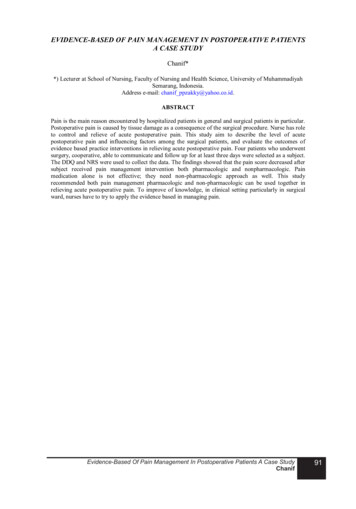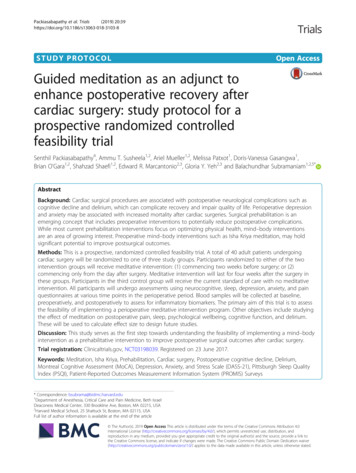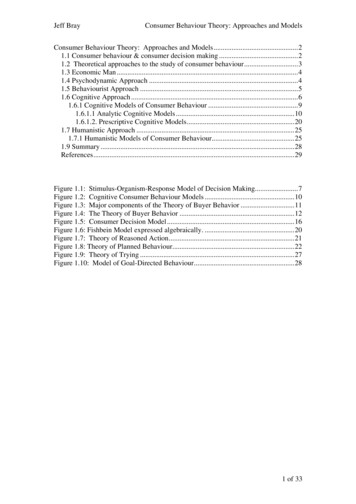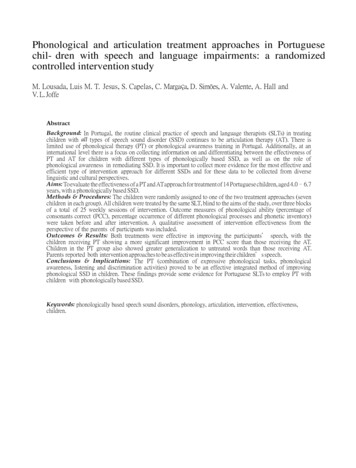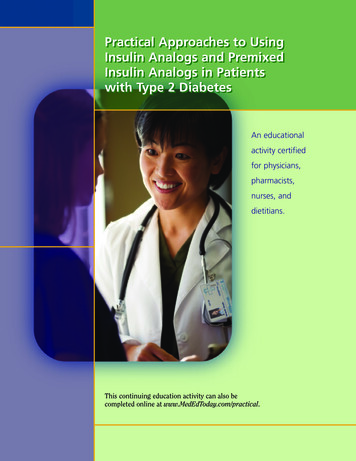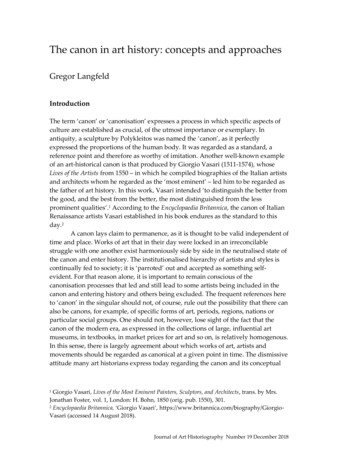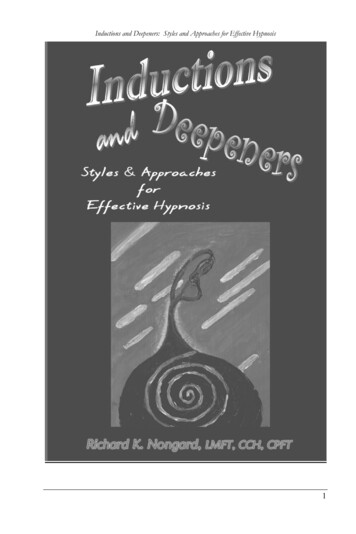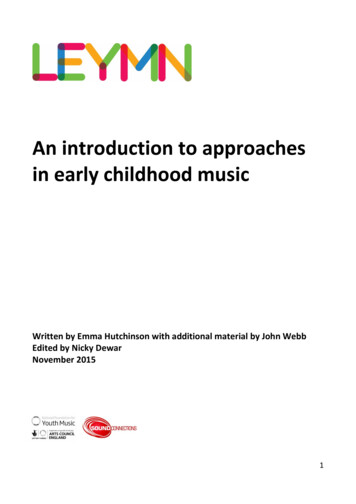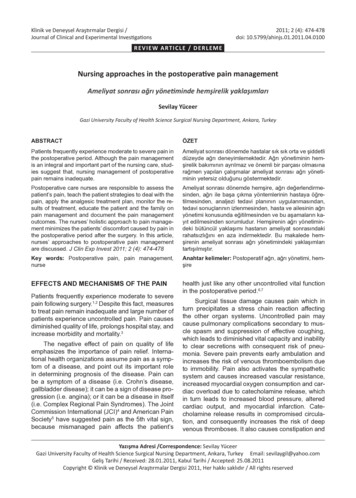
Transcription
Klinik ve Deneysel Araştırmalar Dergisi /S. Yüceer. Postoperative pain management474Journal of Clinical and Experimental Investigations2011; 2 (4): 474-478doi: 10.5799/ahinjs.01.2011.04.0100REVIEW ARTICLE / DERLEMENursing approaches in the postoperative pain managementAmeliyat sonrası ağrı yönetiminde hemşirelik yaklaşımlarıSevilay YüceerGazi University Faculty of Health Science Surgical Nursing Department, Ankara, TurkeyABSTRACTÖZETPatients frequently experience moderate to severe pain inthe postoperative period. Although the pain managementis an integral and important part of the nursing care, studies suggest that, nursing management of postoperativepain remains inadequate.Ameliyat sonrası dönemde hastalar sık sık orta ve şiddetlidüzeyde ağrı deneyimlemektedir. Ağrı yönetiminin hemşirelik bakımının ayrılmaz ve önemli bir parçası olmasınarağmen yapılan çalışmalar ameliyat sonrası ağrı yönetiminin yetersiz olduğunu göstermektedir.Postoperative care nurses are responsible to assess thepatient’s pain, teach the patient strategies to deal with thepain, apply the analgesic treatment plan, monitor the results of treatment, educate the patient and the family onpain management and document the pain managementoutcomes. The nurses’ holistic approach to pain management minimizes the patients’ discomfort caused by pain inthe postoperative period after the surgery. In this article,nurses’ approaches to postoperative pain managementare discussed. J Clin Exp Invest 2011; 2 (4): 474-478Ameliyat sonrası dönemde hemşire, ağrı değerlendirmesinden, ağrı ile başa çıkma yöntemlerinin hastaya öğretilmesinden, analjezi tedavi planının uygulanmasından,tedavi sonuçlarının izlenmesinden, hasta ve ailesinin ağrıyönetimi konusunda eğitilmesinden ve bu aşamaların kayıt edilmesinden sorumludur. Hemşirenin ağrı yönetimindeki bütüncül yaklaşımı hastanın ameliyat sonrasındakirahatsızlığını en aza indirmektedir. Bu makalede hemşirenin ameliyat sonrası ağrı yönetimindeki yaklaşımlarıtartışılmıştır.Key words: Postoperative pain, pain management,nurseAnahtar kelimeler: Postoperatif ağrı, ağrı yönetimi, hemşireEFFECTS AND MECHANISMS OF THE PAINhealth just like any other uncontrolled vital functionin the postoperative period.6,7Patients frequently experience moderate to severepain following surgery.1,2 Despite this fact, measuresto treat pain remain inadequate and large number ofpatients experience uncontrolled pain. Pain causesdiminished quality of life, prolongs hospital stay, andincrease morbidity and mortality.3The negative effect of pain on quality of lifeemphasizes the importance of pain relief. International health organizations assume pain as a symptom of a disease, and point out its important rolein determining prognosis of the disease. Pain canbe a symptom of a disease (i.e. Crohn’s disease,gallbladder disease); it can be a sign of disease progression (i.e. angina); or it can be a disease in itself(i.e. Complex Regional Pain Syndromes). The JointCommission International (JCI)4 and American PainSociety5 have suggested pain as the 5th vital sign,because mismanaged pain affects the patient’sSurgical tissue damage causes pain which inturn precipitates a stress chain reaction affectingthe other organ systems. Uncontrolled pain maycause pulmonary complications secondary to muscle spasm and suppression of effective coughing,which leads to diminished vital capacity and inabilityto clear secretions with consequent risk of pneumonia. Severe pain prevents early ambulation andincreases the risk of venous thromboembolism dueto immobility. Pain also activates the sympatheticsystem and causes increased vascular resistance,increased myocardial oxygen consumption and cardiac overload due to catecholamine release, whichin turn leads to increased blood pressure, alteredcardiac output, and myocardial infarction. Catecholamine release results in compromised circulation, and consequently increases the risk of deepvenous thromboses. It also causes constipation andYazışma Adresi /Correspondence: Sevilay YüceerGazi University Faculty of Health Science Surgical Nursing Department, Ankara, Turkey Email: sevilaygil@yahoo.comGeliş Tarihi / Received: 28.01.2011, Kabul Tarihi / Accepted: 25.08.2011J Clin Exp Investwww.clinexpinvest.orgVol 2, reservedNo 4, December 2011Copyright Klinik ve Deneysel AraştırmalarDergisi 2011, Her hakkı saklıdır / All rights
S. Yüceer. Postoperative pain managementurinary retention by decreasing gastrointestinal andsplanchnic blood flow.8-10Whereas inadequate control of pain may causethe effects mentioned above, excessive or improper use of the pain medications may lead to othercomplications by causing oversedation. Oversedation may affect the systemic vascular resistanceand cardiac output resulting in hypotension, whichin turn causes slowing of the oxygen transport tothe tissues. Oversedation may cause systemic hypotension due to decreased vascular resistanceand diminished cardiac output, which by slowingthe circulation give way to compromised tissue oxygen delivery and changes in the tissue oxygen consumption.11 Evidently, oversedation is a risk factor inthe postoperative period; hence vital signs such asblood pressure, heart rate, breathing, besides oximetry, capnometry and level of consciousness mustbe monitored while the postoperative pain is beingtreated.11,12 This argument emphasizes the importance of pain control in decreasing the morbidityand mortality in the postoperative period.Prior studies indicate that the great majority of the patients suffer from moderate to severepain after surgery, which suggest that the healthcare personnel fail to control the postoperative paineffectively.1,8 Aslan and Badir,13 mention in theirpublication that 58% of the physicians and nursesfail to take appropriate countermeasures to preventthe postoperative pain due to their lack of knowledge, even though pain management clearly is anintegral part of nursing care.14,15 The most importantdistinction is that the nurse, who is the key person inpain management, is in the position to spend a longer time with the patient.16 This unity with the patientenables the nurse a holistic approach to the painmanagement in terms of being acquainted with thepatient’s previous pain experience and coping skills;at the same time teaching the patient effective painmanagement methods, giving guidance, and implementing pain treatment plan, and documenting theoutcome of the same.17,18The effective postoperative pain managementaims at minimizing or eliminating patient’s discomfort due to pain, facilitating rapid recovery and returning to full function, reducing morbidity, limitingthe hospital stay, and preventing recurrence of painrelated problems.10 Postoperative pain management includes assessment of the pain, monitoringand correction of pain related complications, patientand family education, and documentation of theprocess to allow further reassessment of the painmanagement approaches.19J Clin Exp Invest475ASSESSMENT OF THE PAINIn order to manage the postoperative pain effectively, the pain level must be measured appropriately.The goals of pain assessment are to determine thepain severity, help choose the analgesic dosage,which is appropriate to that particular level of pain,and document the effectiveness of pain treatment.Ideally, the patient is encouraged to actively participate in pain assessment, evaluation of pain regularly on a standard scale, and reassessment of thepain when an unexpected increase occurs.18,20Pain assessment starts at the time of admission and should include an assessment of the patient’s activities of daily living (ADL) and pain andstress coping skills. Patient’s questions should beanswered in order to better plan postoperative paincontrol strategies. In the postoperative period, it isimportant to assess the cause of pain (i.e. whetherthe patient’s pain is related to the surgical incision,other surgical trauma or medical complications suchas acute myocardial infaction). Since a patient’s response to pain is specific to that person, pain shouldbe evaluated individually. The issues that the nursemust pay attention when assessing the postoperative pain including the following:10,20-22 Assess pain both at rest and on movement toevaluate the patient’s functional status. Take into consideration patient self-report ofpain and implement the proper pain scale, document the intensity, quality, location, timing & duration, aggravating and alleviating factors, and priorpain treatments and their effectiveness. The effect of a given treatment is evaluatedby assessing pain before and after every treatmentintervention. In the surgical Post Anesthesia Care Unit(PACU) or other circumstances where pain is intense, evaluate, treat, and re-evaluate frequently(e.g. every 15 min initially, then every 1-2 h as painintensity decreases). On the surgical ward, evaluate, treat, and reevaluate regularly (e.g. every 4-8 h) both the painand the patient’s response to treatment. Define the maximum pain score above whichpain relief is offered (the intervention threshold). Forexample, verbal ratings score of 3 at rest and 4 onmoving, on a 10-point scale. Patients who have difficulty communicating(e.g. cognitively impaired, children, and patientswhose level of education or cultural background differs significantly from that of their health care team)their pain require particular attention.www.clinexpinvest.orgVol 2, No 4, December 2011
S. Yüceer. Postoperative pain management476 Unexpected intense pain, particularly if associated with altered vital signs, (hypotension, tachycardia, or fever), is immediately evaluated. New diagnoses, such as wound dehiscence,infection, or deep venous thrombosis, should beconsidered.ate. Family members are involved when appropri Document the pain assessment carefully. Report the results to the pain managementteam.Studies indicate that the nursing assessmentof postoperative pain management is inadequate;Ozer et al.15 report that 74.5% of the nurses do notuse a pain scale when assessing patient’s pain and47.4% only observe patient’s pain behavior ratherthan using any scale.Sloman et al.21 point out that the pain scoresdocumented by the nurses are significantly lowerthan the scores reported by the patients, which isconsistent with results of Ahlers et al.23 Despite thefocus on meeting standards of care in the area ofpostoperative pain management, there is an overwhelming lack of patient reassessment by nursesafter the administration of analgesics.24TREATMENT OF THE PAINClinicians who care for patients have an ethical obligation to treatment postoperative pain and sufferingusing a combination of approaches pharmacological and non-pharmacological methods.25 Importantaspects for pain are tabulated below:22,24 Administer analgesics on “around the clockbasis” not “as needed”. Individualize the dosage. Because of short-term use, opioid addiction isnot a concern in the postoperative period. Calculate the dosage based on the sedationlevel, respiratory status, preexisting conditions, opioid tolerance, and severity of the pain not on theduration of the pain. Utilize the most convenient route of administration. When using Patient Controlled Analgesia(PCA), explain the method and familiarize the patient with the device. Educate the patient about PCA. Routes of administration of PCA are varied such as oral, sublingual, subcutaneous, nasal, intramuscular, intravenous and epidural.J Clin Exp Invest Avoid using placebo because administeringplacebo may erode the trust relationship betweenthe patient and the health care workers.26 Also,American Society for Pain Management Nursing(ASPM),26 American Pain Society,27 National Pharmaceutical Council and JCI have important positionstatements on the use of placebo drugs.26The role of the nurse in control of postoperativepain also includes the following:17,29 Administer pain medication in a timely mannerbefore the scheduled painful procedures such as,dressing change, physical therapy etc. Monitor pain treatment outcome. Utilize of non-pharmacological means to makethe pain tolerable. Provide a suitable calm environment for thepatient. Eliminate other sources of discomfort, such asfull bladder, infiltration of IV etc. Reposition the patient regularly to eliminatepressure sores and enhance circulation. Encourage patient to move extremities while inthe bed because activity decreases muscle spasmand booster circulation.Edwards et al.30 investigated nursing knowledge regarding opioid use in control of pain. Thisstudy comprising 800 nurses, points out that thenurses have several unsubstantiated negative opinions about opioids, which may cause failure of paintreatment. A study by Yava31 investigating the effect of nursing procedures on postoperative patientoutcome, showed that the nurses have incompleteknowledge, especially in the area of medications.MONITORING OF COMPLICATIONSDue to the fact that too high or too low blood levelsof opioids may both result in complications, patientswho are under treatment for pain need to be closelymonitored.32,33 The expectation from nursing servicein regard to monitoring of pain treatment relatedcomplications include the following:29 Observation of side effects of pain treatmentsuch as respiratory depression, oversedation, constipation). Certain opioids e.g. meperidine when administered in prolonged or high doses may cause musclerigidity and seizures, which require close observation of the patient when such medications are used(i.e. for demeprol the usual dosage is 50 mg to 150mg orally, every 3 or 4 hours as necessary).www.clinexpinvest.orgVol 2, No 4, December 2011
S. Yüceer. Postoperative pain management Certain patients such as with asthma, COPD,and other breathing problems may have respiratorydepression and other side effects due to opioids,which again require careful monitoring. Naloxone should be readily available to treatrespiratory depression for patients taking opioids
integral part of nursing care.14,15 The most important distinction is that the nurse, who is the key person in pain management, is in the position to spend a lon- ger time with the patient.16 This unity with the patient enables the nurse a holistic approach to the pain management in terms of being acquainted with the patient’s previous pain experience and coping skills; at the same time .
